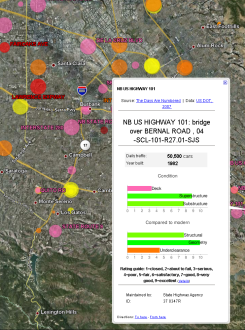When the map view is zoomed very far out so that you see whole countries and continents, only a small subset of regionated data will be visible, to avoid clutter. In this case, bridge rating provides a scoring metric, so only the most critical bridges are shown at first. As the view zooms in, more and more bridges will appear until you see all available data for the small piece of the map you are looking at.
The map is only showing the bridges with the lowest condition ratings. Out of total 716,000 bridges, 189,000 bridges, or 26%, are shown. A bridge is shown if its worst condition rating is 5 or less. The ratings go from 0 to 10 for each of several bridge components that are independent from each other(see a separate post for details).
Disclaimer: Federal Highway Administration (FHWA) does not approve, endorse, or recommend this project.
Click here to open the visualization in Google Earth.
 If you don't have Google Earth, download it. If you have Google Earth plugin installed, scroll down to see the embedded view. Otherwise, here's a sample picture.
If you don't have Google Earth, download it. If you have Google Earth plugin installed, scroll down to see the embedded view. Otherwise, here's a sample picture.This was implemented using regionator - a free, open-source program that converts spreadsheets in CSV format into KML files. Feel free to contact me if you would like to know details or learn to do this yourself.
Each bridge is represented by a circle. Click on any of them to open a description balloon. It will show the road names, daily traffic count, bar charts with specific ratings, the year bridge was built and organization responsible for maintenance. All of these were taken from the original data (and dozens of other fields are available). Unfortunately, bridges are sometimes not located precisely where they should be - they could be several hundred feet or more off (some are in Iceland!).
Circle size shows the amount of daily traffic, and circle color shows what the condition of a bridge is:
| Rating | 0 (broken) | 1 (closed) | 2 (critical) | 3 (serious) | 4 (poor) | 5 (fair) |
|---|---|---|---|---|---|---|
| Color | Black | Black | Red | Pink | Orange | Yellow |


